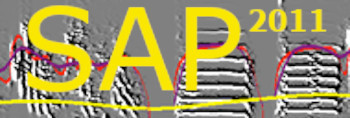Input and output settings
| < PREVIOUS: The main window | > NEXT: Animals and tables |
|
|
|
|
|
|
|
To check for this, go the the SAP recorder and click the Recording tab.The Sound input and output monitor shows the que of sound files generated by the recorder that are waiting to be processed. In case the cue is empty it could be either because all sound has been processed already or because the output folder of the SAP recorder (labeled as "Stage 1 sound folder" is not the same as the input folder of this module. You should first validate that the input and output chans are correctly specified.
 The blue strings in the box represent the wave files cue waiting for analysis. Below, you can see the last saved file.
Important: Please make sure that input folder and output folder ends with "\".
Input settings: Remember that the input of this application is the output of the Recorder. Any sound file saved by the recorder should appear on the file-list window. You must make sure that the input folder is correctly specified. You can click the buttons to navigate to the appropriate folder, or type the folder address in the edit box. However you can do this only when the engine is stopped or when the channel is paused.
Output settings: the output of the sound processor is divided into three categories.
Sound output The first channel in the sound output is where sound files that matched a criteria (e.g., sound files that contain song bouts) will be moved to. Note that other files are permanently deleted (see batch operations for some alterative approaches of sorting rather than deleting files). Sound files are not only moved, but also renamed. By default, SAP2011 ignores the original input file name and generates a file name with the following file annotation format:
R449_39365.70262828_10_10_19_31_2.wav
Note that the same date & time stamp is also used as a serial_number in the syllable database, allowing easy access to the raw sound data of each syllable.
Should I save all the sound files? In many cases, you will find that the most significant issue is the load of accumulating sound files on your hard disk. You may ask yourself if saving all the raw data is indeed necessary. The practical answer to this question is that with appropriate maintenance, saving the entire sound data is inexpensive and easy. The cost of a DVD/R disk is now down to $1 (when buying in bulk), and the overall cost of saving the entire vocal ontogeny is about $15. SAP2011 provides an easy way of saving raw sound files and keeping track of the data. Raw data are an asset that our community may use and reuse and saving raw data is generally a good idea.
Saving sound output through the network: You may define the output folder pass as a standard network address. E.g., //Peterson_computer/c/SAP/bird1/ will work just like a local folder address. Note however, that the network might crush. If SAP2011 detects a network crush or inaccessibility to a computer, it will revert to save the sounds to a default local drive, called c:\rescue\. If this has happened, take your time, solve the network problem, and then click ‘stop’ and then ‘start’ to resume the selected destination you previously set to the Sound Processing Live engine.
|
|
